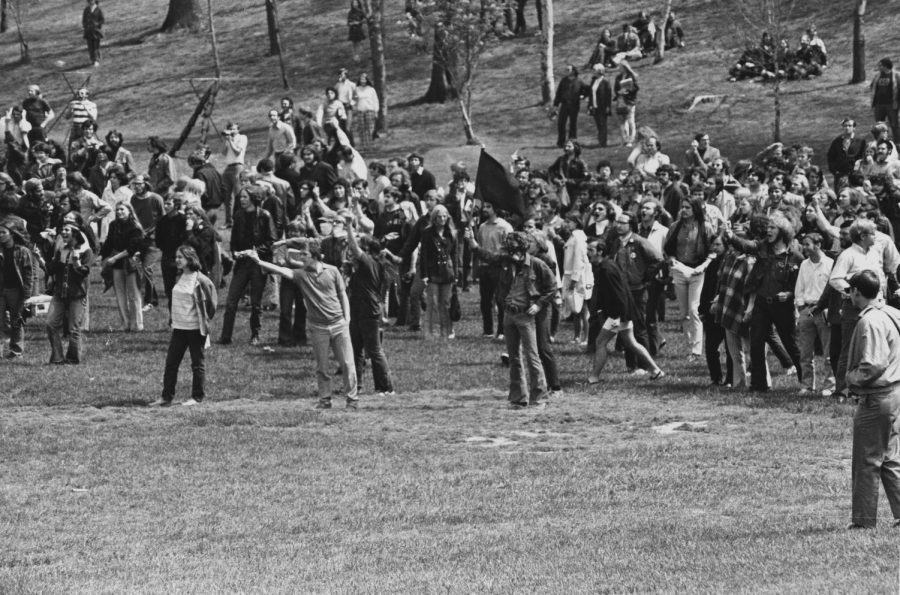#Hashtag May 4: Misappropriation in the social media era
May 1, 2019
How does May 4 fit into the social media-saturated world of our culture today?
Have you ever sat and thought … what would the hashtag be?
We’re immersed in a social-driven age, and it seems as if every social movement is accompanied by the four crossed lines. It becomes our activism. Our fight for change. Our way of bringing awareness to issues that are important to our generation. Sometimes seen at the crossroads of powerful and pointless. Sometimes seen as a way for young people to use their voice. We’ve seen movements like #bringbackourgirls, #Metoo, and #Marchforourlives dominate Twitter feeds and result in action. A hashtag is just a social media tool, but it creates this feeling that we are part of a community that’s making change, but really it’s the bare minimum of activism.
The impact of May 4 left college kids all over the country in outrage. Students banning together, standing in solidarity, all motivated to make a change. There were no computers. There were no smartphones. There were only thousands of students dedicated to making a real change. They used their voices in real life, and sought out real action.They used their bravery to stand for what they truly believed in.
Even though students then didn’t have social media or even computers, they were connecting and inspiring one another. With social media, we have so much power than we’ve ever had. We can reach thousands of people in seconds, and we can learn from many college students who used their voices in the absence of the hashtag era when thinking about our activism.
#oneofakindvintage
It wasn’t the first time the retailer Urban Outfitters featured a controversial clothing piece. It’s regretfully sold a shampoo targeted toward “suicidal hair,” and a V-neck stamped with the words “eat less.” However, in September 2014, a “one of a kind” vintage Kent State shirt ignited a media outrage. The pink tye-dye sweatshirt featured red splatters that reminded many of blood stains. Many viewed the retailer as insensitive to the Kent State shooting that left four students dead. The company spoke out, issuing a reasoning and apology saying that the shirt was part of its sun-faded vintage collection and the blood stains and holes were discoloration from the sweatshirts’ original shade and from natural wear and fray.
The university responded to the clothing company’s decision to sell the shirt, saying the item was in poor taste and trivializes a loss of life that still hurts the Kent State community today. The university also invited leaders of the company, and the person who invested in the item, to the May 4 Visitors Center in order to gain perspective on its meaning.
#LSUVSKSU
Along the balcony of Louisiana State’s Delta Kappa Epsilon house, a large sign flowing in a football season breeze read “Getting Massacred Is Nothing New to Kent St.” The sign hung before a football game against Kent State was meant to evoke a harmless rivalry before the game, or possibly reference Kent State’s football record. However, the usage of the word “massacre” also referenced the 1970 shootings.
Kent State released a statement saying, “We take offense to the actions of a few people last night who created an inappropriate sign and distracted from the athletic contest on the field.” The fraternity apologized and admitted the sign was inappropriate and should never have been hung in the first place.
#graduatingtoopencarry
Kent State alumna Kaitlin Bennett took to Twitter shortly after graduating to tweet a graduation photo of herself in a white dress, black suede wedges, an AR-10 swung around her back and a graduation cap that read, “Come and get it.” She captioned her photo with “Now that I graduated from Kent State, I can finally arm myself on campus. I should of been able to do so as a student especially since four unarmed students were shot and killed by the government on this campus.”
Her controversial post and opinionated statements went viral nationally. Bennett told Campus Reform she worries the university’s gun policy limits students’ abilities to protect themselves on campus. “I believe not only that those four students would still be alive today had they had the right to carry on campus, but that students today would be much safer,” she said.
Since May 4, there have been a few cheap misappropriations of the event, but to use such a tragic event to create attention, a punchline to a joke or entertainment is completely disrespecting the Kent State community and the lives lost. In the age of social media, some of these events have been magnified. The May 4 presence on social media should be better served when the tragedy is represented in a positive light, such as positive representations like the opening credits of the 2009 film “Watchmen,” which featured a creative take on the shooting in a way that was not misappropriating the tragedy.
Faith Riggs is a contributor. Contact her at [email protected].
























